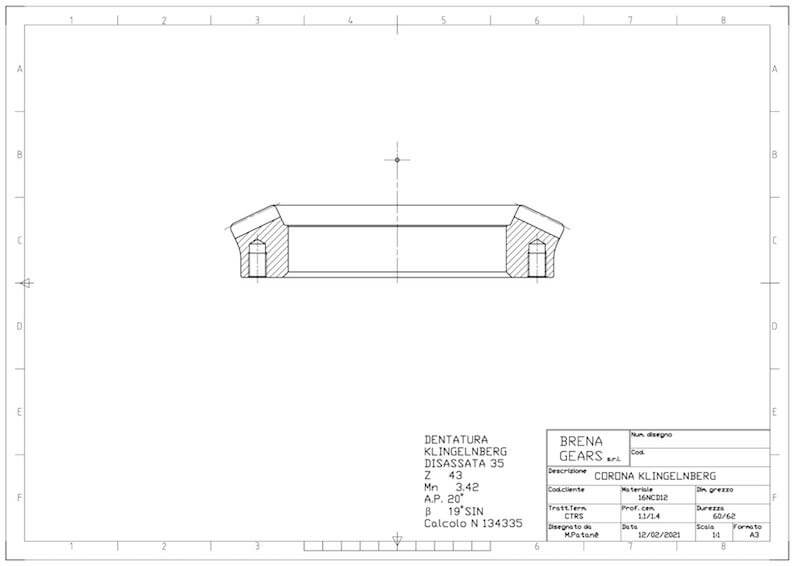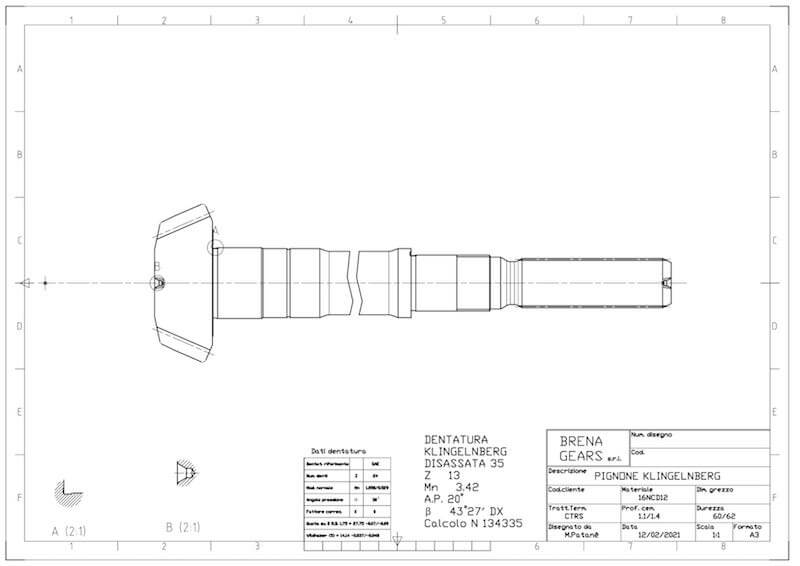Products
Klingelnberg Couplings
thanks to “HPG-S” grinding system
The teeth are ground using tungsten carbide and borazon. This machining method allows chips to be removed on the hundredth with the final result of a complete absence of micro-cracks and burns on the tooth surface.
The machining of these spiral-toothed bevel gears is carried out on very powerful machining machines that mill the teeth in continuous motion and produce them by means of an enveloping curve through the cyclo-palloid system.
The shapers generating the wheel surface are configured in such a way that they form a small part of the spiral with each multiple start. By determining a suitable spiral angle, a high meshing value is also achieved with this type of bevel gears. In such a way, two or more teeth always remain in mesh under load. Therefore – thanks to the achievable toothing of the highest quality – the best possible noise-free conditions are guaranteed. Klingelnberg bevel gears have a uniform height over the entire toothed surface and are therefore less likely to be subject to both assembly errors (displacement from the specified installation dimension) and no alignment errors on the axles, thus ensuring a higher load capacity.
Thanks to these features, it is possible to have a 30-40% higher transmission capacity when using Klingelnberg bevel gears, compared to Gleason bevel gears, considering the same dimensions. In addition, a high safety factor against tooth breakage can be achieved by using shapers with a suitable root radius. As a conclusion, Klingelnberg bevel gears allow great advantages in both mounting and loaded deformation without significantly changing the meshing point and the meshing itself.
The manufacturing process naturally includes the machining of the tooth flanks after hardening using the HPG-S method, which at the end of the machining process gives the preferred method of meshing and a very smooth application due to the extremely low surface roughness that can be achieved. The final quality obtained is better than that of the finished grinding wheels, as this finishing method does not produce micro-cracks or burns on the tooth surface, which instead represent a recurrent potential risk in grinding operations.
| Machining of Klingelnberg teeth and HPG-regrinding after heat treatment | ||
| Min. Module | 1.2 | |
| Max. Module | 14 | |
| Max. teeth diameter | 1200 | |
| Max. shaft’s diameter | 220 | |
| Grinding machining for Klingelnberg’s teeth/td> | ||
| Min. Module | 1 | |
| Max. Module | 8 | |
| Max. teeth diameter (Ratio 1:1) | 300 | |
| Max. shaft’s diameter (Ratio 1:5) | 410 | |
| Max. deviation | +/-50 | |
| Spiral angle | 0/60 | |
Discover all our products


